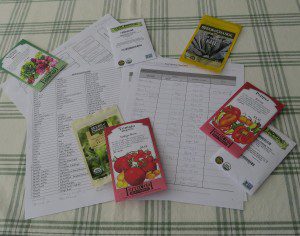Crop rotation – Why it’s so important!

As gardeners, we aim to thwart insects and plant diseases, right? Well, one of the best tools we have is vegetable crop rotation.
I know, crop rotation sounds like something farmers do, not small-time gardeners. And yet it makes a huge difference no matter what size your garden is.
Why is it so important? Certain insects and diseases are common to the plants within specific plant families. For example, Colorado potato beetles and various blights are unique to the nightshade family, which includes potatoes, tomatoes, eggplants, peppers and tomatillos.
By moving around where you plant any of these crops in the garden each year, you are thwarting some pretty nasty pests and diseases. That’s a simple enough task, right?
There are only two requirements for being successful at crop rotation:
- keep records of where your plantings are located each year
- know your plant families
 Step #1 is easy. A garden journal, binder or notebook is all you need to note your planting layouts. I use a 4-year rotation for my vegetable garden. Each year, when I’m deciding the current year’s layout, I pull out my charts from the previous 3 years. Then I slowly work my way through the list of crops I want to grow and make sure I don’t plant them where they, or other members of their plant family, were growing in the last 3 years.
Step #1 is easy. A garden journal, binder or notebook is all you need to note your planting layouts. I use a 4-year rotation for my vegetable garden. Each year, when I’m deciding the current year’s layout, I pull out my charts from the previous 3 years. Then I slowly work my way through the list of crops I want to grow and make sure I don’t plant them where they, or other members of their plant family, were growing in the last 3 years.
Step #2 will be easy for you in a moment because all you need to do is refer to my “Vegetable Plant Families” guide!
But before you do, let me just give you a quick example of what I’m referring to:
When you are trying to decide where to plant your tomatoes this year, look through your records from the past 3-4 years to make sure that you’ve chosen an area or bed that hasn’t had tomatoes, potatoes, eggplants, peppers or tomatillos growing in it.
From the research and reading I’ve done in the past few years, it would appear that the nightshade family is the most important family of crops that you want to rotate as they can have the most serious disease problems. That makes it worth the effort right there, doesn’t it?
One last thought: if you have a really small garden — and if you only grow a couple of different types of veggies — how do you rotate your crops? I agree that this is a challenge. The best thing you can do is move them around in your plot as best you can and to also choose varieties that are disease-resistant.
